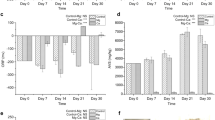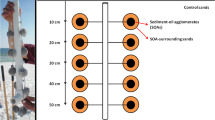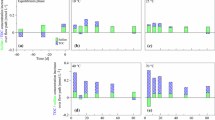Abstract
Black layer is a condition of high-sand-content golf greens that results in a subsurface blackened layer in the sand produced by sulfate-reducing bacteria. Black layer can be the product of an interaction of cyanobacteria and sulfate-reducing bacteria and may or may not be toxic to the grass growing on the sand. The organic byproducts of the cyanobacteria coat and plug the sand thereby creating an anoxic environment for development of the sulfate- reducing bacteria. The present study was initiated to determine the range of gaseous hydrocarbons evolved from black layered sand produced by the interaction of two genera of cyanobacteria, Nostoc and Oscillatoria, and Desulfovibrio desulfuricans. The gaseous hydrocarbons measured included methane, ethane, ethylene, and propylene. In nonblackened sand, Nostoc evolved the highest levels of these gases, Oscillatoria evolved relatively low levels except for propylene, and D. desulfuricans evolved the smallest quantities of the gases. When the cyanobacteria and D. desulfuricans were combined to develop black layered sand some changes occurred in the evolution of the gases. Evolution of the gases from Nostoc + D. desulfuricans decreased or remained the same relative to Nostoc alone, and increased relative to D. desulfuricans alone. Except for propylene evolution, gases from Oscillatoria + D. desulfuricans increased relative to Oscillatoria or D. desulfuricans alone. Propylene evolution from Oscillatoria + D. desulfuricans remained unchanged relative to Oscillatoria alone, but increased relative to D. desulfuricans alone. The gases measured are discussed relative to the organisms observed and the conditions of the study.
Similar content being viewed by others
References
Abdollahi H and Wimpenny J W T 1990 Effects of oxygen on the growth of Desulfovibrio desulfuricans. J. Gen. Microbiol. 136, 1025-1030.
Bauld J, Burne R V, Chambers L A, Ferguson J and Skyring G W 1980 Sedimentological and geobiological studies of intertidal cyanobacterial mats in north-eastern Spencer Gulf, South Australia. In Biochemistry of Ancient and Modern Environments. Eds. P A Trudinger, M R Walter and B J Ralph. pp 157-166. Australian Academy of Science, Canberra.
Brendt W L and Vargas J M Jr 1992 Elemental sulfur lowers redox potential and provides sulfide in putting greens. HortScience 27, 1188-1190.
Cullimore D R, Nilson S, Taylor S and Nelson K 1990 Structure of black plug layer in a turfgrass putting sand green. J. Soil Water Conserv. 45, 657-659.
Cypionka H, Widdel F and Pfenning N 1985 Survival of sulfate-reducing bacteria after oxygen stress and growth in sulfate-free oxygen sulfide gradients. FEMS Microb. Ecol. 85, 31-42.
Davis J B and Squires R M 1954 Detection of microbially produced gaseous hydrocarbons other than methane. Science 119, 381-382.
De Boks P A, Huber T F, Van Nes W J, Van Den Oosterkamp P F, Van Bekkum H, Van Eybergen G C, Van Den Hende J H, Kossen N W F, Mooring C I, Oudejans J C, Snaterse A C and Wesselingh J A 1982 Process for the continuous conversion of glucose to hydrocarbons. Biotechnol. Let. 4, 447-452.
Dilling W and Cypionka H 1990 Aerobic respiration in the sulfate-reducing bacteria. FEMS Microbiol. Let. 71, 123-128.
Frankenberger W T and Arshad M 1995 Phytohormones in Soils. Marcel Dekker,Inc., New York. pp 301-435.
Gallon J R, Hashem M A and Chaplin A E 1991 Nitrogen fixation by Oscillatoria spp. under autotrophic and phototrophic conditions. J. Gen. Microbiol. 137, 31-39.
Gerasimenko L M and Zavarzin G A 1983 Exchange of hydrogen, carbon dioxide, oxygen, and methane in cyanobacterial cenosis. Microbiology 51, 577-580.
Gerhardt P 1981 Manual of Methods for General Bacteriology. American Society of Microbiology, Washington, DC.
Hastings D and Emerson S 1988 Sulfate reduction in the presence of low oxygen levels in the water column of the Cariaco Trench. Limnol. Oceanogr. 33, 391-396.
Hoagland D R and Arnon D I 1950 The Water-Culture Method for Growing Plants Without Soil. California Agriculture Experiment Station Circular 347, University of California, Berkeley.
Hodges C F 1992a Interaction of cyanobacteria and sulfate-reducing bacteria in subsurface black layer formation in high-sand content golf greens. Soil Biol. Biochem. 24, 15-20.
Hodges C F 1992b Growth of Agrostis palustris in subsurface black layered sand induced by cyanobacteria and sulfate-reducing bacteria. Plant Soil 142, 91-96.
Hunt J M, Miller R J and Whelan J K 1980 Formation of C4–C7 hydrocarbons frombacterial degradation of naturally occurring hydrocarbons. Nature 288, 577-578.
Jorgensen B B 1977a Bacterial sulfate reduction within reduced microniches of oxidized marine sediments. Mar. Biol. 41, 7-17.
Jorgensen B B and Cohen Y 1977b Solar Lake (Sinai). 5. The sulfur cycle of the benthic cyanobacterial mats. Limnol. Oceanogr. 22, 657-666.
Kimmerer T W and Kozlowski T T 1982 Ethylene, ethane, acetaldehyde, and ethanol production by plants under stress. Plant Physiol. 69, 840-847.
Kumar G N M and Knowles N R 1993 Changes in lipid peroxidation and lipolytic free-radical scavenging enzyme activities during aging and sprouting of potato (Solanum tuberosum) seed-tubers. Plant Physiol. 102, 115-124.
Lindblad P, Atkins C A and Pate J S 1991 N2-fixation by freshly isolated Nostoc from coralloid roots of the cycad Macrozamia riedlei (Fisch. ex Gaud.) Gardn. Plant Physiol. 95, 753-759.
Linderbach S K and Cullimore D R 1989 Preliminary in vitro observations on the bacteriology of the black plug layer phenomenon associated with the biofouling of golf greens. J. Appl. Bact. 67, 11-17.
Marshall C, Frenzel P and Cypionka H 1993 Influence of oxygen on sulfate-reduction and growth of sulfate-reducing bacteria. Arch. Microbiol. 159, 168-173.
Pavlica D A, Hora T S, Bradshaw J J, Skogerboe R K and Baker R 1978 Volatiles from soil influencing activities of soil fungi. Phytopathology 68, 758-765.
Pegg G F 1985 Pathogenic and non-pathogenic microorganisms and insects. In Hormonal Regulation of Development III. Encyclopedia of Plant Physiology, New Series, Vol. 11. Eds. R P Pharis and D M Reid. pp 599-624. Springer-Verlag, Berlin.
Postgate J R 1969 Methane as a minor product of pyruvate metabolism by sulphate-reducing and other bacteria. J. Gen. Microbiol. 57, 293-302.
Postgate J R 1984 The Sulfate-Reducing Bacteria. Cambridge University Press, Cambridge.
Postgate J R, Kent H M, Hill S and Blackburn H 1985 Nitrogen fixation by Desulfovibrio gigas and other species of Desulfovibrio. In Nitrogen Fixation and CO2 Metabolism. Eds. P W Ludden and J E Burris. pp 225-234. Elsevier, New York.
Prosperi C, Luna C and Valiente E F 1993 Influence of pH, light intensity andoxygen on the short-term effect of ammonium on nitrogenase activity of cyanobacteria from rice fields. Environ. Exp. Bot. 4, 545-552.
Riederer-Henderson M A and Wilson P W 1970 Nitrogen fixation by sulphate-reducing bacteria. J. Gen. Microbiol. 61, 27-31.
Rippka R, Deruelles J, Waterbury J B, Herdman M and Stanier R Y 1979 Generic assignments, strain histories and properties of pure cultures of cyanobacteria. J. Gen. Microbiol. 111, 1-61.
Sisler F D and Zobell C E 1951 Hydrogen utilization by some marine sulfate-reducing bacteria. J. Bact. 62, 117-127.
Skyring G W and Chambers L A 1980 Sulfate reduction in intertidal sediments. In Sulfur in Australia. Eds. J R Freney and A J Nicolson. pp 88-94. Australian Academy of Sciences, Canberra.
Skyring G W, Chambers L A and Bauld J 1983 Sulfate reduction in sedimentscolonized by cyanobacteria, Spencer Gulf, South Australia. Austr. J. Mar. Freshanet. Res. 34, 359-374.
Smith K A and Restall W F 1971 The occurrence of ethylene in anaerobic soil. J. Soil Sci. 4, 430-443.
Tate R L 1995 Soil Microbiology. John Wiley & Sons, Inc. New York. pp 283-306.
Toledo G, Bashan Y and Soeldner A 1995 Cyanobacteria and black mangroves in Northwestern Mexico: colonization, and diurnal and seasonal nitrogen fixation on aerial roots. Can. J. Microbiol. 41, 999-1011.
Van Cleemput O, El-Sebaay A S and Baert L 1982 Production of gaseous hydrocarbons in soil. In Physico-Chemical Behavior of Atmospheric Pollutants. Eds. B Versino and H Ott. pp 349-355. D. Reidel Publishing Co., Dordrecht, Holland.
Van Cleemput O, El-Sebaay A S and Baert L 1983 Evolution of gaseous hydrocarbons from soil: Effect of moisture content and nitrate level. Soil Biol. Biochem. 15, 519-524.
Van Cleemput O and El-Sebaay A S 1985 Gaseous hydrocarbons in soils. Adv. Agron. 38, 159-181.
Ward D M and Olson G T 1980 Terminal processes in the anaerobic degradation of an algal-bacterial mat in a high sulfate hot springs. Appl. Environ. Microbiol. 40, 67-74.
Widdel F 1988 Microbiology and ecology of sulfate-and sulfurreducing bacteria. In Biology of Anaerobic Microorganisms. Ed. A J B Zehnder. pp 469-585. John Wiley & Sons, New York.
Zeikus J G, Dawson M A, Thompson T E, Ingvorsen K and Hatchikan E C 1983 Microbial ecology of volcanic sulphidogenesis: Isolation and characterization of Thermodesulfobacterium commune gen. nov. and sp. nov. J. Gen. Microbiol. 129, 1159-1169.
Author information
Authors and Affiliations
Rights and permissions
About this article
Cite this article
Hodges, C.F., Campbell, D.A. Gaseous hydrocarbons associated with black layer induced by the interaction of cyanobacteria and Desulfovibrio desulfuricans†. Plant and Soil 205, 77–83 (1998). https://doi.org/10.1023/A:1004361407061
Issue Date:
DOI: https://doi.org/10.1023/A:1004361407061




